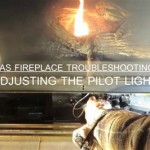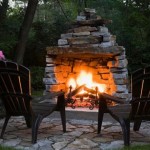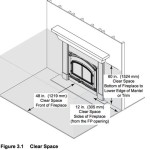Natural Gas Fireplace Installation: A Comprehensive Guide
Natural gas fireplaces offer a convenient and efficient alternative to traditional wood-burning fireplaces. They provide consistent heat, require minimal maintenance, and eliminate the need for firewood storage and disposal. However, the safe and effective operation of a natural gas fireplace hinges on proper installation. This article provides a comprehensive guide to the key aspects of natural gas fireplace installation, emphasizing safety protocols and adherence to local codes.
Before commencing any installation work, it is crucial to consult local building codes and obtain the necessary permits. These regulations vary geographically and may dictate specific requirements for gas line connections, ventilation, and clearances. Failure to comply with these codes can result in fines and potential safety hazards. It is also highly recommended to engage a qualified and licensed professional for the installation. They possess the expertise and experience to ensure the fireplace is installed correctly and safely.
Planning and Preparation
The first step involves carefully selecting the appropriate natural gas fireplace for the intended space. Consider the room size, heating requirements, and aesthetic preferences. Fireplaces are rated in British Thermal Units (BTUs), which indicate their heating capacity. An undersized fireplace will not adequately heat the room, while an oversized unit may lead to overheating and inefficient energy consumption. A thorough assessment of the room's dimensions and insulation levels is necessary to determine the optimal BTU rating.
Once the fireplace model is chosen, prepare the installation site. This includes clearing the area of any obstructions, such as furniture or flammable materials. Ensure adequate ventilation is available, as most natural gas fireplaces require a vent to the outside to expel combustion byproducts. The vent can be either a direct vent, which draws air from outside for combustion, or a B-vent, which relies on natural draft. The type of venting required will depend on the fireplace model and local building codes.
Furthermore, a suitable gas supply line must be available. If a gas line is not already present at the installation location, a qualified plumber will need to run a new line from the gas meter. The gas line must be adequately sized to provide sufficient gas pressure to the fireplace. Improperly sized gas lines can lead to inconsistent flame and reduced heating performance. Before working on any gas lines, it is imperative to shut off the gas supply to the house at the meter and test for leaks after any connections are made.
Connecting the Gas Supply
Connecting the natural gas supply is a critical step that requires meticulous attention to detail. Ensure the gas supply is shut off at the meter before commencing any work on the gas line. Use appropriate fittings and sealant specifically designed for natural gas applications. Avoid using Teflon tape on gas line connections, as it can degrade over time and lead to leaks. Pipe thread compound, or pipe dope, formulated for gas lines, is the recommended sealant.
The gas line should be connected to the fireplace's gas valve using a union fitting. This allows for easy disconnection of the fireplace for maintenance or repairs. After making the connection, carefully test for leaks using a soap and water solution. Apply the solution to all joints and connections. If bubbles appear, it indicates a leak, which must be corrected immediately. Never use an open flame to test for gas leaks.
Once the gas connection is secure and leak-free, double-check the gas pressure entering the fireplace. Most fireplaces require a specific gas pressure for optimal operation, typically measured in inches of water column. Use a manometer to measure the gas pressure and adjust the regulator, if necessary, to meet the manufacturer's specifications. Operating the fireplace with incorrect gas pressure can damage the unit and create a safety hazard.
Venting and Clearances
Proper venting is essential for the safe and efficient operation of a natural gas fireplace. The venting system must be installed according to the manufacturer's instructions and local building codes. Ensure the vent is appropriately sized and installed with the correct slope to allow for proper exhaust of combustion byproducts. Improperly installed venting can lead to carbon monoxide buildup, a potentially fatal hazard.
Direct vent fireplaces require a specific type of venting that draws air from outside for combustion and expels exhaust gases through the same vent. B-vent fireplaces rely on natural draft to draw air from inside the house and vent exhaust gases through a chimney. Both types of venting systems must be inspected regularly for blockages or leaks. Debris, such as leaves or bird nests, can obstruct the vent and impede proper airflow.
Maintaining proper clearances around the fireplace is also crucial for safety. Follow the manufacturer's instructions regarding the minimum distance between the fireplace and combustible materials, such as walls, furniture, and curtains. Failure to maintain these clearances can lead to overheating and potential fire hazards. Consider installing a heat shield if combustible materials are located close to the fireplace.
After the installation is complete, thoroughly test the fireplace to ensure it is operating correctly. Check for any leaks, unusual noises, or other issues. It is vital to have the installation inspected by a qualified professional to verify compliance with local codes and safety standards. This inspection provides an additional layer of assurance and ensures the fireplace is operating safely and efficiently. Finally, familiarize oneself with the fireplace's operating instructions and safety guidelines before regular use.

How To Install A Gas Fireplace Diy Built In

Fireplace Installations Near Dc Chimney Experts

Adding A Gas Fireplace To An Existing Home Just Log Fires

If You Have A Gas Fireplace It May Or Not Chimney Flue

Efficient Prefab Gas Fireplaces Fireplace Showroom In Tilton Nh

How To Install A Fireplace Insert Diy Save Money

How To Install A Gas Fireplace Diy Built In

7 Benefits Of Installing A Gas Fireplace Low Maintenance Much More

Convert To Gas Installing Fireplace Inserts Doctor Flue

How Much Does It Cost To Install A Gas Fireplace Homeserve Usa
Related Posts








